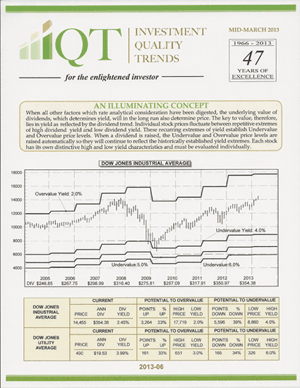While more stocks are gathering in the overvalued camp, there are still bargains to be had, says Kelley Wright of Investment Quality Trends.
There has been a great deal of talk lately about the primary trend, which is most likely attributable to the Dow Industrials and the Dow Transports having established new all-time closing highs. The term "primary trend" comes from Dow Theory.
Dow Theory suggests there are three major market trends: the primary, secondary, and minor. The primary trend is the major or dominant trend of the market. A secondary trend moves in the opposite direction of the primary trend, which is to say that it is a correction to the primary trend. The minor trend is also a corrective trend that generally moves against the direction of the secondary trend.
According to Dow Theory, the most important trend to identify is the primary trend and the three phases within the primary trend: The early or accumulation phase; the middle phase; and the panic or blow-off excess phase.
The early phase typically begins at the end of a downturn, when sentiment is poor and fear is at a high. This is when the greatest values exist (read: historically repetitive high yields) and knowledgeable investors with large pools of capital step in to snap up the values.
In the middle phase, negative sentiment begins to abate as business conditions improve, which is often defined by higher earnings and dividends, as well as mergers and acquisitions. This is also when greater numbers of investors begin to venture back into the markets and send prices ever higher.
The panic or blow-off excess phase of the primary trend is the final phase in the uptrend, where everything is wine and roses and there is nothing ahead but blue skies as far as the eyes can see. This is typically where the early entrants to the uptrend are selling their positions to the late arrivals, those who wait for new all-time highs before they step back into the markets.
The trends we’re most interested in are the trends of values. Value, by our definition, is identified by a historically repetitive area of high dividend yield. This pertains to both individual stocks as well as the Dow Jones Industrial Average.
In our Measures of the Market, we note that the low-yield Overvalue area for the Dow is a dividend-yield of 2%. Based on the current composite dividend of $354.28 and the closing price of 14,455.28 at the time of publication, the dividend yield of the Dow stands at 2.45%.
Also based on the current composite dividend, there is approximately 3,300 points or 23% more upside potential before the dividend yield of the Dow will decline to 2%.
The Undervalued category of our Select Blue Chip universe has fallen below the 17% level, and the Overvalued category now contains a greater percentage of stocks than does our Undervalued category.
The primary trend in the Dow is up, confirmed by the Industrial and Transportation Averages establishing new, all-time highs.
If I were a betting man, I would wager that the primary trend is definitely not the early phase. The trend is your friend until it isn’t...that's how the old Wall Street adage goes. When it ends nobody knows, but one thing I can guarantee you is there won’t be an announcement.
Stocks in the Undervalued area still represent good values, and should be fine as long as their dividends are well protected by lower payout ratios and lower levels of long-term debt to equity. Stocks that are at or within 10% of Overvalue have delivered well, and prudence would dictate some downside protection, such as a stop-loss, is in order.
Subscribe to Investment Quality Trends here...
Related Articles:
Cyclical Six and the 2013 Market






















